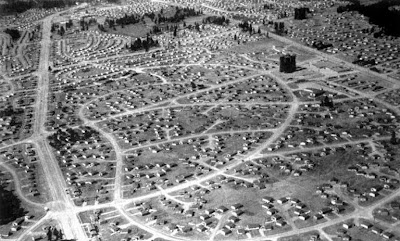

 Update: Image uploading seems to be working now so I will add images.
Update: Image uploading seems to be working now so I will add images. America, since its first settlement by Europeans, has developed an intense cult of individuality. In many cases the new settlers were those whose individuality was too strong to allow them to remain comfortably in Europe. They set out to the New World as individuals. Upon arriving, they strode into the woods and individually carved sites for themselves, and, perhaps most importantly, they rolled up their shirtsleeves and began building their own individual houses. This notion of the heroic individual-builder played a major role in establishing another great American ideal, that of the utopian pastoral community. For the first 250 years of European settlement in America, development and expansion were seen as a social panacea. If deserving and upright Americans could acquire their own homes, the thought was, they could surely achieve the ideal of Protestant morality to which the country aspired. Yet gradually this aspiration fell apart. By the 1960s and 70s Americans were starting to see the shortcomings in their grand suburban dreams which had somehow fallen short of the ideal community they were supposed to foster. And while there are certainly numerous factors behind the gradual debauching of the American suburban ideal, the diminishing of the individual’s role in home selection and construction can be traced along a parallel trajectory.
America, since its first settlement by Europeans, has developed an intense cult of individuality. In many cases the new settlers were those whose individuality was too strong to allow them to remain comfortably in Europe. They set out to the New World as individuals. Upon arriving, they strode into the woods and individually carved sites for themselves, and, perhaps most importantly, they rolled up their shirtsleeves and began building their own individual houses. This notion of the heroic individual-builder played a major role in establishing another great American ideal, that of the utopian pastoral community. For the first 250 years of European settlement in America, development and expansion were seen as a social panacea. If deserving and upright Americans could acquire their own homes, the thought was, they could surely achieve the ideal of Protestant morality to which the country aspired. Yet gradually this aspiration fell apart. By the 1960s and 70s Americans were starting to see the shortcomings in their grand suburban dreams which had somehow fallen short of the ideal community they were supposed to foster. And while there are certainly numerous factors behind the gradual debauching of the American suburban ideal, the diminishing of the individual’s role in home selection and construction can be traced along a parallel trajectory.Horace
Images: I couldn't figure out how to add captions so I guess I will describe them here. 1: Architect's model for suburban house. Even simple "undesigned" vernacular architecture (which is intended to derive from the inherited styles that had been designed by homeowners themselves) now adheres to prescribed models. 2: Aerial view of defense housing (i.e. for returning GI's) in Vancouver, WA. Shows the anonymity and homogeneity of post-war suburban housing.
3: Page from Federal Housing Administration pamphlet advising subdividers on how to properly arrange lots. The act of carving one's space out of the wilderness, previously a very individual and independent act (see next image) also becomes ordained by corporate or government authorities.
4: "Among the Pines/A First Settlement" Currier and Ives Lithograph; ca. 1850's.
This image is in contrast to the previous 3 as it shows the early rural ideal of the American settler making it on their own in the wilderness.
This looks cool - I am always interested to read about this phenomenon of American individuality, which I think is different from most any other culture. It takes on interesting strains of consumerism, frontier ideology, work ethic, etc. that I think can be argued as creative and respected or destructive and foolish. I'm not particularly sure of where you plan to go in your discussion of suburban development - will you take a design approach or a cultural approach or both? Be clearer about what you plan to say in the beginning so that we can see the unique elements throughout the paper
ReplyDeleteI think your introduction may be too broad- it seemed to jump from individualism to pastoral communities to suburbia without clear links. I'm also not so sure what the paper is going to be about- maybe focus more on the loss of individuality in the suburbs- if that is your main argument.
ReplyDeleteThe idea of the individual in relation to the home seems to be a topic Professor Hayden loves!
ReplyDeleteGenerally, I agree with the other comments--get a little more specific, because it's not exactly clear where you're going with this introduction.
Yes - try to be a little more clear in your project description.
ReplyDelete